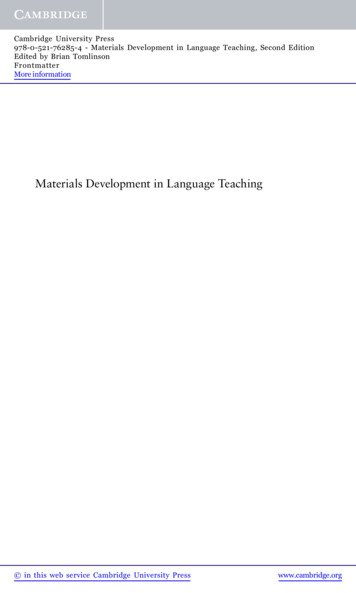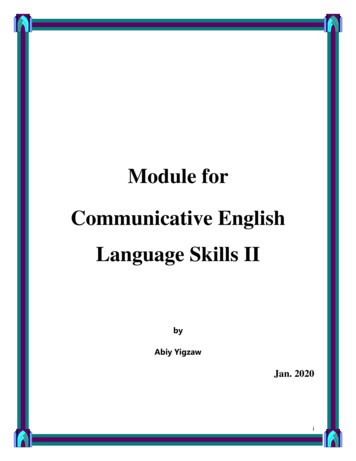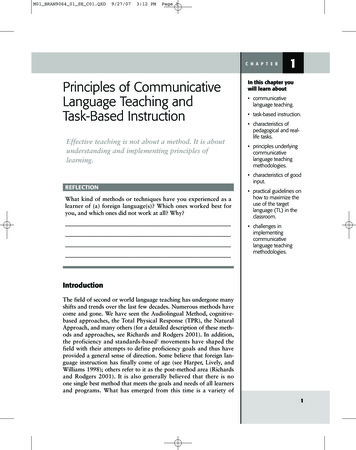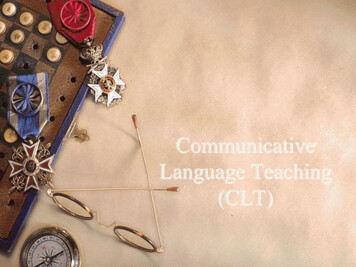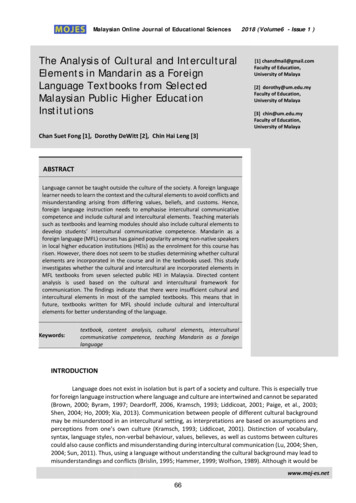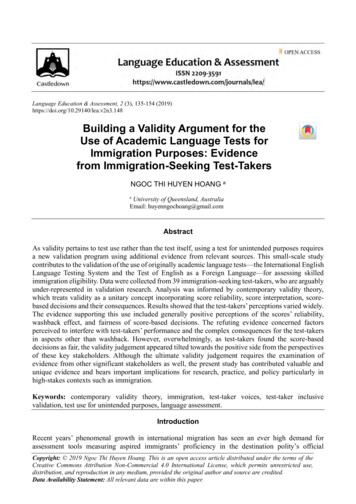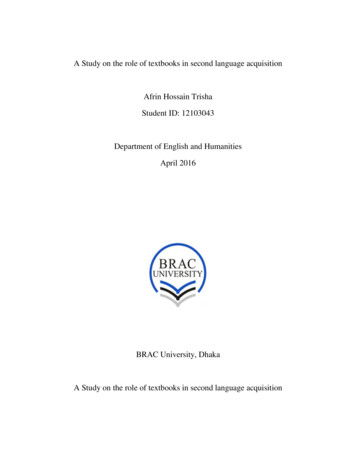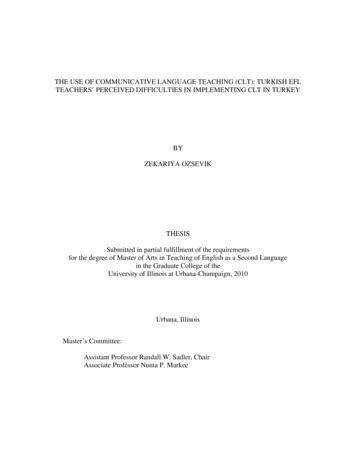
Transcription
THE USE OF COMMUNICATIVE LANGUAGE TEACHING (CLT): TURKISH EFLTEACHERS’ PERCEIVED DIFFICULTIES IN IMPLEMENTING CLT IN TURKEYBYZEKARIYA OZSEVIKTHESISSubmitted in partial fulfillment of the requirementsfor the degree of Master of Arts in Teaching of English as a Second Languagein the Graduate College of theUniversity of Illinois at Urbana-Champaign, 2010Urbana, IllinoisMaster’s Committee:Assistant Professor Randall W. Sadler, ChairAssociate Professor Numa P. Markee
ABSTRACTCLT has been widely explored and studied by many researchers in the field of Englishlanguage teaching. There have been many studies conducted on the use of CLT in EFL settings.However, there are only few studies in number that specifically deal with CLT and itsimplementation in the Turkish context. Hence, this study was designed to investigate the TurkishEFL teachers’ understanding of English teaching, predominantly the difficulties and challengesthey face in the implementation of CLT practices in the Turkish context.This study first presents an overview of English language teaching in Turkey, and theninvestigates the definition and principles of CLT which is followed by a brief history of CLT. Inaddition, a review of existing literature related to communicative competence, as well as how itfunctions in CLT is presented. Furthermore, this study examines the impact of ESL vs. EFLcontexts on the implementation of CLT methodology.A mixed methods research design was used for this research. Participants for this studywere sixty-one Turkish teachers of English teaching at primary and secondary levels. The mainmodes of data collection consisted of online questionnaire and semi-structured and informalinterviews.The results show that Turkish EFL teachers, whilst aware of the achievements, observemany difficulties in implementing CLT in their classrooms. These difficulties stem from fourdirections, namely, the teacher, the students, the educational system, and CLT itself. The resultssuggest that despite showing keen interest in change and being eager to identify with CLT,Turkish teachers are not rather optimistic about the complete adoption of CLT, and thus feel thatonly by overcoming the difficulties from those four sources, and by establishing more favorableconditions for the implementation of CLT can teachers truly benefit from CLT in their Englishclassrooms.ii
To my Fiancéeiii
ACKNOWLEDGEMENTSThis thesis would not have been possible without the assistance and support of manyindividuals. I wish to acknowledge and express my appreciation of these people for theirinvaluable contributions.First, I would like to give thanks to my beloved family for being my source of strengthand inspiration during this journey. My mother, father, brother, and sisters have all beensupportive in many ways, and I am grateful to have them in my life.Second, I owe my deepest gratitude to my advisor and chair of my examinationcommittee, Randall Sadler, for all the time and expertise given so freely throughout the course ofthe study. I am particularly indebted to him for generously offering me his understanding,support, and advice when I most needed them and his care for and interest in my work, as well ashelping me grow as a researcher along the way. I would also like to thank to my examinationcommittee member, Numa Markee, whose expertise in the field, encouragement, guidance, andsupport from the initial to the final level enabled me to develop an understanding of the subject.Many thanks also go to my dear friends and colleagues who did not hesitate to offer ahand or suggestions during difficult times. I cannot thank them enough for their unfailing supportand friendship.My sincere appreciation is also extended to the sixty-one Turkish EFL teachers whoparticipated in the study. I am truly grateful for their time, trust, and commitment.Finally, a special thank-you is reserved for my beloved fiancée, Derya, for her support,love, understanding, and constant encouragement which kept me focused and helped me find thestrength to continue when things got tough. I would not have made it without her unwaveringfaith in my ability to successfully complete my study.iv
TABLE OF CONTENTSCHAPTER 1: INTRODUCTION AND OVERVIEW .11.1 Introduction and Statement of the Problem.11.2 Significance of the Study .21.3 Focus of the Study .4CHAPTER 2: REVIEW OF THE LITERATURE .52.1 An Overview of English Teaching in Turkey .52.1.1 History of English Teaching in Turkey .52.1.2 How English Has Been Taught in Turkey.142.1.3 The Current English Teaching Curriculum .162.2 Communicative Language Teaching .222.2.1 History of CLT .232.2.2 Definition and Principles of CLT .272.2.3 Communicative Competence.322.2.4 Classroom Activities in CLT .382.2.5 Teachers and Students’ Roles in CLT Classroom .422.2.6 Differentiating ESL and EFL Environments .442.2.7 Use of CLT in EFL Contexts and Barriers to Adopting CLT .48CHAPTER 3: METHODOLOGY .533.1 Research Design .533.2 Participants .543.3 Instruments .583.3.1 Written Questionnaires .593.3.2 Interviews .613.4 Data Collection Procedures .623.5 Data Analysis .64v
CHAPTER 4: FINDINGS OF THE STUDY .664.1 Attitudes Towards English and ELT Profession .664.2 Concerns Over the Problems in English Teaching in Turkey .674.2.1 Large Classes .684.2.2 Teachers’ Heavy Workload .694.2.3 Heavily-loaded Program.724.2.4 Mismatch Between Curriculum and Assessment .734.2.5 Students’ Poor Communicative Abilities .754.2.6 Students’ Low Motivation .774.3 Desire for Changes in English Teaching in Turkey .784.4 Understanding of CLT and Its Potential for English Teaching in Turkey .804.5 Difficulties and Challenges in Implementing CLT in Turkey .854.5.1 Teacher-related Difficulties and Challenges .854.5.2 Student-related Difficulties and Challenges .924.5.3 Difficulties and Challenges Related to the Educational System .984.5.4 CLT-related Difficulties and Challenges.105CHAPTER 5: DISCUSSION.1105.1 Inconsistent Differences in the Teachers’ Responses .1105.2 Consistency Between the Results and the Literature .1125.3 Research Questions Revisited .1145.3.1 What Problems Are Inherent in English Teaching in Turkey? .1145.3.2 What Can Communicative Language Teaching Contribute to English Teaching inTurkey? .1175.3.3 How Feasible Is Communicative Language Teaching in Turkey? .1175.3.4 What Are the Difficulties That Turkish EFL Teachers Face in Their Attempts toUse CLT? Can These Difficulties Be Overcome? If Yes, How, and toWhat Extent? .118vi
CHAPTER 6: CONCLUSION .1216.1 Implications of the Study .1216.2 Limitations of the Study .1246.3 Suggestions for Future Research .125REFERENCES .128APPENDIX A: SAMPLE SURVEY QUESTIONNAIRE .137APPENDIX B: SAMPLE INTERVIEW QUESTIONS .144APPENDIX C: INFORMED CONSENT FORM .146vii
LIST OF TABLESTable 1. Differences between TESL and TEFL .47Table 2. Gender ratio of survey participants .55Table 3. Teaching experience of survey participants .56Table 4. School setting/type of survey participants .56Table 5. Background of interview participants .58Table 6. Problems inherent in English teaching in Turkey .68Table 7. Survey participants perceptions about CLT .82Table 8. Survey participants’ experience in using CLT .83Table 9. Study/work abroad experience of survey participants .87viii
LIST OF FIGURESFigure 1. Components of language competence .36Figure 2. Components of communicative language ability in communicative language use .37Figure 3. Age distribution of survey participants .55Figure 4. Institutional distribution of survey participants .57Figure 5. Academic degrees of survey participants .57Figure 6. Average number of students in a classroom .69Figure 7. Number of classes taught by survey participants (per academic year) .71Figure 8. Hours of class taught by survey participants (per week) .71Figure 9. Teachers’ deficiency in spoken English .86Figure 10. Participants’ experience with language teaching methods as language learners .87Figure 11. Teachers’ lack of knowledge about the appropriate use of language in context .88Figure 12. Lack of training in CLT .89Figure 13. Lack of time for developing materials for communicative classes .91Figure 14. Misconceptions about CLT .92Figure 15. Students’ low English proficiency .93Figure 16. Students’ passive style of learning .95Figure 17. Students’ resistance to participate in communicative class activities .96Figure 18. Students’ lack of motivation for developing communicative competence .97Figure 19. Lack of support .99Figure 20. Lack of authentic materials .101Figure 21. Large classes .103Figure 22. Grammar-based examinations .104Figure 23. Lack of effective and efficient assessment instruments .106Figure 24. CLT’s inadequate account of EFL teaching .108Figure 25. Teachers’ perceptions of the size of class and its effects on the use of CLT .111ix
CHAPTER 1INTRODUCTION AND OVERVIEW1.1 INTRODUCTION AND STATEMENT OF THE PROBLEMCommunicative Language Teaching (CLT) as a methodology was first proposed inEngland in the 1970s. This methodology was regarded as revolutionary since it placed anessential emphasis on communication in language learning classrooms. Being primarily an ESL(English as a second language) methodology, it rapidly gained a widespread acceptance in theWestern countries. Following the emergence of CLT in English-speaking countries, it began tospread all over the world. Signifying the new and being endorsed as a reaction against thetraditional language teaching methodologies, CLT has served as a major source of influence onEnglish language teaching practice in both ESL and EFL (English as a foreign language)environments.Despite the apparent popularity of CLT in the last thirty years or so, there have beenopposing views on the appropriateness, as well as the feasibility of implementing CLT in EFLcontexts. Some ELT (English language teaching) scholars have accentuated the significance ofthe local needs and the conditions of the particular EFL contexts, and the benefits of thetraditional methods of language teaching (Bax, 2003; Harvey, 1984; Incecay & Incecay, 2009).Yet some others have taken a strong position for adopting CLT in Asian countries 1 (Li, 1984;Liao, 2004; Maley, 1984). Nevertheless, the majority of the ELT scholars have advocated theidea that neither of these extremist positions will benefit English teaching and learning in Asian1The studies I could find regarding the use of CLT in Asian countries mainly deal with the Chinese, Japanese,Korean, Taiwanese, and Vietnamese contexts.1
contexts. Given the present English teaching circumstances in Asian countries, those researchershave revealed that implementing CLT approach fully in those countries is almost impossible.They have also pointed out that certain barriers be overcome for the effective implementation ofCLT in Asian countries (Burnaby & Sun, 1989; Chick, 1996; Ellis, 1996; Hiep, 2007; Hu, 2002;Li, 1998; Rao, 2002; White, 1989).After more than three decades of discussion, not much has changed in English classroomsin Turkey with regard to moving towards a more communicative approach. The Ministry ofNational Education (MONE) is a government ministry of the Republic of Turkey, responsible forthe supervision of public and private educational system, agreements and authorizations undera national curriculum. Although the current English teaching curriculum imposed by the MONEis clearly based on the CLT methodology, and a student-centered approach has been officiallyadopted, traditional methods such as the Grammar-translation method still dominate the EFLclassroom practices in Turkey. Why is it that teachers hardly ever, if at all, utilize the practices ofCLT in their teaching? What are the reasons for CLT not getting into Turkish EFL classrooms?An investigation of Turkish EFL teachers’ understanding of English teaching, predominantly thedifficulties and challenges they face in the implementation of CLT practices in their classes canbe very informative and provide guidance as to how to introduce CLT in EFL settings moreeffectively and efficiently. Thus, the present study is vital to facilitate positive changes inEnglish teaching, as well as to provide local practitioners real assistance.1.2 SIGNIFICANCE OF THE STUDYCLT has been widely explored and studied by many researchers in the field of Englishlanguage teaching. There have been many studies conducted on the use of CLT in EFL settings(Ellis, 1996; Gorsuch, 2000; Incecay & Incecay, 2009; Li, 1998; Rao, 2002; Sun & Cheng,2
2002). However, there are few studies that specifically deal with CLT and its implementation inthe Turkish contexts (Bal, 2006; Incecay & Incecay, 2009). In addition, due to their insufficientdata, these studies fail in providing a well-documented account of the actual situation in Turkeywith regard to CLT and its utilization in English classrooms. Also, their conclusions are oftenoversimplified. Thus, this study aims to lay out a lucid and thorough description of current ELTpractices in the Turkish context.Furthermore, the literature in Turkey predominantly focused on English teaching atprimary and tertiary level, thereby overlooking English teaching in the secondary schools. Yet,there is a good number of students at the secondary level in Turkey. According to 2007 statistics,out of 14,817,654 students in total, 3,245,322 students were enrolled at the secondary level inTurkey (MONE, 2008). Hence, the current study places a significant emphasis upon the teachersworking for both primary and secondary schools, who have been so far neglected in previousstudies.In addition, the Communicative Approach has been extensively adopted by textbooks andcurricula in second language teaching, especially in ESL countries. This holds true for Turkey,too. In 2007, the MONE in Turkey revised and updated the National English TeachingCurriculum in primary and secondary levels (MONE, 2008). According to this recent reform,CLT has been introduced as the basis of the curriculum, one of the main goals of which isreported to “develop written and oral communication skills of learners” (MONE, 2008). Also,this curriculum dictates that “what matters is the use of language as a means of communicationrather than the rules of grammar” (MONE, 2008). Following the adoption of the new CLT-basedcurriculum, MONE replaced all the existing textbooks used in schools with newly written coursebooks based on the CLT approach. Despite these positive steps taken towards integrating CLT3
methodology into English teaching in Turkey, there seems to be an apparent disparity betweenthe proposed curriculum and the actual classroom practices. Therefore, the present study issignificant in that it aims to inquire about the possible reasons as to why CLT as an innovativeapproach cannot be effectively integrated into English classrooms. Besides, the findings of thisstudy will be useful to the overall use of CLT in other EFL situations, providing insights aboutthe potential issues needed to be addressed for the development of English teaching in differentEFL contexts.1.3 FOCUS OF THE STUDYThis study focuses on the following questions:1. What problems are inherent in English teaching in Turkey?2. What can communicative language teaching contribute to English teaching inTurkey?3. How feasible is communicative language teaching in Turkey?4. What are the difficulties and challenges that Turkish EFL teachers face inimplementing CLT in their English classrooms? Can these difficulties be overcome?How and to what extent?4
CHAPTER 2REVIEW OF THE LITERATUREThe literature review begins with an overview of English language teaching in Turkey toprovide the background to the present study. The second section of this chapter investigates CLTas one of the most recent developments in ESL/EFL teaching methodology. Within thisframework, definition and principles of CLT are explored which then is followed by a briefhistory of CLT. Furthermore, a review of existing literature related to communicativecompetence, as well as how it functions in CLT is presented. In addition, the chapter examinesthe impact of ESL vs. EFL contexts on the implementation of CLT methodology. Finally, thethird section, the most immediately relevant, encompasses studies on the necessity, feasibilityand the explanations of utilizing CLT in Turkey and other EFL contexts.2.1 AN OVERVIEW OF ENGLISH TEACHING IN TURKEYThis section consists of the background to the study which lays out a historical overviewof English teaching in Turkey and how English has been taught so far. The section ends with adetailed account of the current curriculum imposed by the Ministry of National Education(MONE) in Turkey. This information is provided here in order to provide context for the choicesmade in this study.2.1.1 History of English Teaching in TurkeyLocated at the intersection of Asia and Europe and in proximity to the Middle East andAfrica, Turkey plays a strategic and vital role in building peace and stability in the region. The5
geopolitical location of Turkey, together with a status that entails acting as a cultural bridgebetween the East and the West, makes the learning of English particularly significant.There are political reasons for the eagerness to learn English in Turkey, as well. Turkeybecame a member of NATO in 1952 and has started official negotiations with the EuropeanUnion (EU), hoping to achieve full membership. Over the last two decades or so, gaining fullmembership to the EU has always been given the most priority on the political agenda of Turkey.It can be argued that Turkey has taken many steps and come closer to joining the EU. If this canbe accomplished soon, it will be necessary to have civil servants with high competence inEnglish for English is becoming the most dominant official language of the EU. Thus, recentgovernments have adopted policies that support and promote learning and teaching of English. Itis not surprising, therefore, to see the prevailing popularity of English as a foreign language inTurkey.In Turkey, the official language and the medium of instruction in educational institutionsis Turkish. At present, English is the only foreign language that is offered as a required subject atall levels of education in Turkey. There are other foreign languages such as German and French;but these are offered as elective subjects in a very small number of schools.In order to understand the Turkish educational context, it is essential to present ahistorical overview of English teaching in Turkey. It is recognized that the introduction ofEnglish language into the Turkish education system dates back to The Tanzimat Period, thesecond half of the eighteenth century, which marks the beginning of the Westernizationmovements in the education system (Kirkgoz, 2005). This period is succeeded by the RepublicanTurkey which covers the time period between 1923 and 1997. The third milestone in the historyof English teaching in Turkey is considered to be the phase that started with the 1997 Education6
Reform which brought about drastic changes and developments in the educational system, and inparticular the teaching of English in Turkey.2.1.1.1 The Tanzimat Period (1839 - 1876)The Tanzimat Period refers to the period dating back to second half of the nineteenthcentury during the Ottoman times. This period is significant in that it marks the beginning of theWesternization movements in the education system (Kirkgoz, 2005). The foreign languageintroduced during this period was French. The increasing importance of French, which seemed tobe a natural result of teaching the sciences by using French materials and teachers, was one ofthe major changes in language education that the Tanzimat reforms brought about. Davison(1990) argues that “almost from its inception, that empire was physically and politically orientedtoward Europe” (p. 89). In addition, Doran’s report reveals that since the end of the 18th century,the cultural and economic modernization of Turkey has rested upon the reformers’ knowledge ofa Western language (1969).Together with the constant changes in education system in the Ottoman Empire,missionary schools started to flourish. The first educational institution that used English as themedium of instruction was Robert College. This school was founded in 1863 by an Americanmissionary named Cyrus Hamlin. Although these missionary schools initially acceptedArmenian, Bulgarian, Greek, and Jewish students, Turks were also attracted by the Americanschools since the knowledge of English resulted in prestigious and high-paying jobs (Allen,1968).Even though French was the most popular foreign language and very influential at thattime, the American schools increasingly earned a distinct reputation due to the quality and the7
consistency of the education offered in these schools, which eventually gained Englishdominance over other foreign languages. Other reasons for the popularity of these schools amongthe Turks were the elite positions that graduates were able to get, as well as the neutral politicalatmosphere in the schools. As Washburn (1909) unveils in his recollections, this neutralenvironment was primarily created by choosing English as the medium of education.2.1.1.2 Republican Turkey (1923 - 1997)After the establishment of the Republic of Turkey in 1923, Ataturk, the founder of therepublic, and his associates initialized a series of reforms, aiming to create an independent andmodern country. Among these reforms, education was given a special attention. Education, forinstance, was made accessible to everyone, all the schools were unified, the alphabet waschanged from Arabic to Latin, and schools were secularized. In short, as Eskicumali (1994)writes, a “new” mentality, outlook and value system was introduced in the Turkish society. Hegoes on to say that “education undoubtedly played one of the most important roles in thetransformation of the new country” (p. 101). Ataturk himself realized the utmost need to improveeducation; yet, there were no clear goals and principles. There were two groups of people crucialto help with the necessary transformation. Of these, the first group was the Turkish pedagogicalreformers. These people were predominantly educated in the Western type schools during theOttoman Period. Therefore, they spoke a foreign language and they were highly influenced byforeign education systems. As pointed out by Childress (2001), a “Westernized elite made up ofsecularized intellectuals and bureaucrats took charge of reforming education” (p. 65). The secondgroup of people was foreign experts who were invited to Turkey during the first few decades ofthe new Republic. The new government established by Ataturk highlighted the importance ofadopting Western culture and scientific ideas. Eskicumali (1994) proposes that this emphasis8
became evident when the government allocated one-fourth of its educational budget toconsultation with foreign experts, the first of who was John Dewey.It was not until 1943 that the issue of foreign language teaching, in particular English wasmentioned at the National Education Summit, the highest level of meetings held by The Board ofEducation and Discipline (BOED) every four years and that discusses the education-relatedissues at the national level. Because illiteracy was a major problem during the first decades of theRepublic, the foreign language teaching evidently would not be a priority. The BOEDestablished a foreign language teaching policy only in 1988.Startin
were sixty-one Turkish teachers of English teaching at primary and secondary levels. The main modes of data collection consisted of online questionnaire and semi-structured and informal interviews. The results show that Turkish EFL teachers, whilst aware of the achievements, observe m
